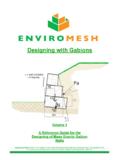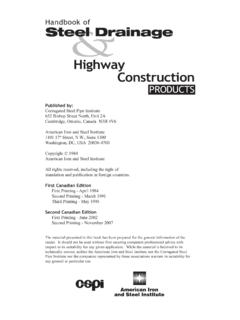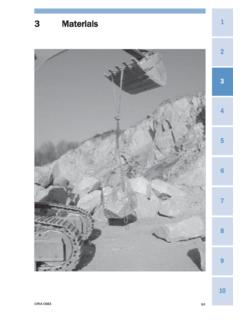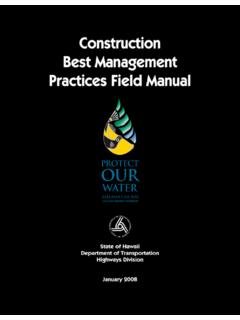Transcription of 1. Retaining Wall Types - CRW Engineering
1 MOA Project #10-026 Golden View Drive Intersection & Safety Upgrades Draft Design Study Report March 2012 68 Appropriate transitions can include extending the insulation beyond the roadway improvements, reducing the insulation thickness, or angling the insulation downward. Use of a frost tolerant section, an alternative to the insulated section, may be warranted where subgrade soil has low to moderate frost susceptibility or where groundwater is relatively deep and subgrade soil is not saturated most of the year. A frost tolerant section could be considered at the beginning of the project, from approximate station 508+00 to about station 520+00. Soil borings in this area encountered shallow weathered rock, between feet to 12 feet below ground surface.
2 A frost tolerant section may also be considered at the north end of the project, between approximate stations 590+00 to 599+50. General appearance of the pavement surface suggests that roadway performance in this segment is better than the remainder of the alignment. A frost tolerant section in these two segments would consist of approximately feet of NFS fill material. For both an insulated and frost tolerant section, a non-woven geotextile is included along the base of the structural section to separate the native silty subgrade materials from the imported subbase fill. When peat is exposed in the base of the excavation, it is recommended that the peat be excavated out and replaced with imported fill.
3 Retaining walls to the steep adjacent terrain along the project corridor, Retaining walls will be required to reduce the impacts from roadway grading and slopes. Retaining walls should be installed as needed to minimize impacts to utilities, the environment, and adjacent properties. 1. Retaining Wall Types Below is a description of the four basic Types of Retaining walls along with their characteristics. MOA Project #10-026 Golden View Drive Intersection & Safety Upgrades Draft Design Study Report March 2012 69 Example rock- gabion Retaining wall Example modular block Retaining wallGravity: Gravity Retaining walls rely on the mass of the wall structure for stability.
4 The wall mass must be sufficient to counteract sliding and overturning forces from the retained soil. These systems can use stone, concrete or other heavy material as well as mechanically stabilized earth (MSE) for stability. These are the most common type of Retaining walls and include gabions, bin walls , and modular block concrete construction. In most cases the slope behind the wall needs to be temporarily removed during construction. For mechanically stabilized earth walls , the reinforcing often extends horizontally into the embankment about as far as the exposed wall face is tall. Piling: Piling Retaining walls have structures that extend significantly below grade to provide support to counteract horizontal forces from the retained soils.
5 Typically two thirds of the structure height is embedded below grade. The structures are usually steel sheet piles or H beams. Piles are driven into the soil while H beams can either be driven in or set into drilled holes. Quite often, the structural face of a piling wall is covered with a facade of concrete blocks or panels. These are some of the most expensive Types of Retaining walls but they do allow construction with very little removal of soil behind the wall. Cantilever: Cantilever Retaining walls have a large effective mass due to the soil placed over a horizontal section of the wall. These walls are typically constructed of cast-in-place, reinforced concrete.
6 The horizontal (cantilevered) leg of the MOA Project #10-026 Golden View Drive Intersection & Safety Upgrades Draft Design Study Report March 2012 70 structure can either extend back into the retained soil or out away from the slope. The slope behind the wall typically needs to be temporarily removed during construction. Cantilever walls are relatively expensive due to the work required to build concrete forms, install reinforcing, pour concrete, and provide joints between pours. The concrete needs ample time to cure before the soil can be replaced behind the wall. Anchored: Anchored (or tieback) Retaining walls use cables driven horizontally into the soil to counteract opposing horizontal forces from the retained soils.
7 The anchors, which typically pull horizontal plates or sheets against the soil, can be soil nails, tieback cables, or screw anchors. The soil behind the wall does not need to be removed during construction. The anchors may need to extend into Basic Types of Retaining walls MOA Project #10-026 Golden View Drive Intersection & Safety Upgrades Draft Design Study Report March 2012 71 the embankment quite a ways, which can impact buried utilities or future development. Combination: Many Retaining walls use a combination of the above Types . For example, many piling walls use anchors to reduce embedment depth and structure strength. 2. Considerations Below are important considerations that affect the decision to provide a Retaining wall and which type of wall should be constructed.
8 The decision to construct a Retaining wall can be subjective and must balance the cost of installing a Retaining wall with the overall impacts to utilities, wetlands, the environment, or adjacent properties. Impacts to wetlands often demand construction of Retaining walls due to permitting requirements to avoid or minimize wetlands impacts if possible. Exact locations of Retaining walls will require further refinement during the design phase. Embankment Impacts: Gravity and cantilever Retaining walls typically require some of the soil behind the wall to be temporarily removed during construction. In some cases the slope can be cut to stand near vertical for short periods of time to reduce impacts but OSHA embankment guidelines and worker safety must be accounted for.
9 Piling walls can minimize impacts to adjacent properties and structures. Foundation Soils: Gravity and cantilever Retaining walls require a solid foundation to resist the forces of the wall and soil. Where foundation soils are weak, a piling or anchor wall should be considered or the weak soil replaced. The bedrock encountered near the south end of the Golden View Drive project provides an excellent foundation but makes driving sheet piles very difficult (see APPENDIX E for the geotechnical report). Groundwater/Drainage: Groundwater needs to be removed from behind the Retaining wall to reduce hydrostatic forces. Many Types of wall are inherently porous while other Types , like reinforced concrete, require weep holes to be integrated into the design to relieve pressure from water behind the wall.
10 In areas where substantial groundwater and glaciation is expected, a subdrain should be MOA Project #10-026 Golden View Drive Intersection & Safety Upgrades Draft Design Study Report March 2012 72 considered to direct the runoff to drainage ditches or a piped storm drain collection system. Utilities: Some Types of Retaining walls impact a considerable amount of soil behind the face of the wall. For example, modular block walls and MSE walls rely on reinforcing geotextile fabric embedded into the soil as part of the structure. The fabric behind the wall can impact existing utilities or limit future placement of utilities. Anchor wall cables also extend into surrounding soils and affect utilities.





